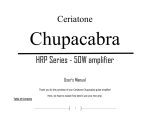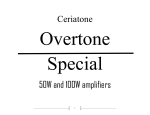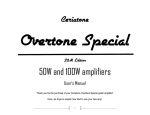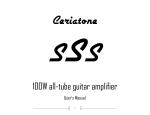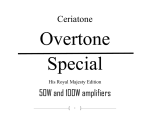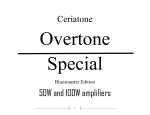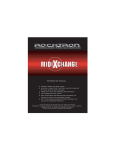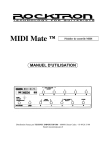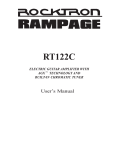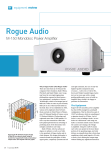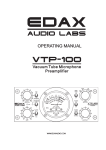Download Ceriatone King Kong User`s manual
Transcript
KING KONG 50W / 100W GUITAR AMPLIFIER User’s Manual 1 Thank you for the purchase of your Ceriatone King Kong guitar amplifier! Here, we hope to explain how best to use your new amp. Table of Contents 1) About the King Kong……….…………………………………………………………………………………………page 2 2) Quick setup……………………………………………………………………………………………………………page 3 3) Front Panel controls………………………………………………………………………………………………….page 4 4) Rear Panel controls…………………………………………………………………………………………………..page 9 5) Tube compliment and external bias jacks and adjustment………………………………………………………page 12 6) Frequently Asked Questions………………………………………………………………………………………...page 16 1) About the King Kong amplifier Our British series of amplifiers has been overwhelmingly popular, and is still the backbone of our amplifier line. A few years ago, we expanded our British series with the HRP series of versatile, yet classically voiced amplifiers. We are now proud to release the flagship of the British and HRP series – the King Kong. This project has been about 5 years in the making and involved countless man-hours to achieve what we perceive as total sonic perfection. King Kong is a fully independent, 2 channel head with unbelievable flexibility with uncompromising tone and performance. Channel 2 draws on the Jose-inspired high gain circuits made famous by other builders. We’ve spent the last few years tirelessly perfecting this circuit, and the result is the most accurate recreation of one of the most storied modern amplifiers. Channel 1 is a slightly revoiced Super Lead preamp to allow both fantastic clean and crunch sounds. Both channels feature our “ERA” controls and various voicing options. We’ve included features like a passive FX loop, bias jacks and external adjustment, pentode/triode switching, and DC regulated preamp tube filaments for lowest noise floor possible. Most of all, we hope the “King” becomes an integral part of your tone equation to exhilarate your playing and music. Rock on! Nik Azam 2 2) QUICK SETUP (for instant gratification) 1) Plug your guitar using a 1/4” instrument cable into the INPUT on the right of the front panel 2) Plug a suitable power cable from the KING’s rear panel MAINS cable inlet to your wall power receptacle 3) Plug the KING into your speaker cabinet using 1/4” speaker cable 4) Set the IMPEDANCE SELECTOR to the match the impedance of your speaker cabinet 5) Set all rotary controls on the front panel to 12:00 (clock face) 6) Set ERA switches to the far right position 7) Set all three BRIGHT switches to the far left positions 8) Set CHARACTER and BITE switches to the far left positions 9) Set FEEL switch down 10) Set front panel POWER switch in the ON position (up position, with adjacent STANDBY switch in the “STANDBY” mode) for 30 seconds to allow tube filaments to warm up 11) Set front panel STANDBY switch to “ON” mode (up position) 12) ROCK!!!!!! 3 3) FRONT PANEL CONTROLS From left to right: 1) INDICATOR LED 2) POWER 2-way toggle switch 3) STANDBY 2-way toggle switch 4) DEEP control with CHARACTER 3-way toggle switch 5) PRESENCE control with BITE 3-way toggle switch 6) MASTER control (Channel 1) with ERA 3-way toggle switch 7) BASS control 8) MIDDLE control 9) TREBLE control 10) GAIN control (Channel 1) with BRIGHT 3-way toggle switch 11) SOLO control (Channel 2) with ERA 3-way toggle switch 12) MASTER control (Channel 2) with ERA 3-way toggle switch 13) BASS control 14) MIDDLE control 15) TREBLE control 16) GAIN 2 control (Channel 2) with BRIGHT 2 3-way toggle switch 17) GAIN 1 control (Channel 2) with BRIGHT 1 3-way toggle switch 18) FEEL 2-way toggle switch 19) CHANNEL 2-way toggle switch 20) INPUT ¼” instrument jack 4 INDICATOR will illuminate when the King Kong is powered by turning the front panel POWER toggle switch to the ON position. If INDICATOR does not turn on, check your power cable connections, and then the fuse on the rear of the unit. POWER two-way toggle switch powers the King Kong on and off. With the toggle switch in the UP (“ON”) position, the King Kong is on. In the DOWN position, the King Kong is OFF. STANDBY applies high voltage to the vacuum tube anodes (and screen grids) during use of the King Kong. To ensure long tube life, first power the unit on with the STANDBY toggle switch in DOWN position for approximately 30 seconds. You can then switch to UP (“ON”) to use the King Kong. With the toggle switch in the DOWN position, the King Kong is in STANDBY mode. In the UP position, the King Kong is in OPERATE mode DEEP adjusts the low and low-mid frequency response of the power amplifier using negative feedback. Use this control to add depth, punch, and “thump” to your tone. Turning this control all the way counter-clockwise defeats this control (and CHARACTER) and removes it from the power amp. CHARACTER adjusts the frequency at which the DEEP control works. To the LEFT is a moderately deep, bass sound. This will add spread to your sound without sounding too modern. The CENTER position dramatically shifts the DEEP control to the low mids, giving a great cut and snarl to your tone. To the RIGHT is the standard, deepest bottom end sound. This gives the amp a huge soundstage and a modern response great for heavier tones. PRESENCE adjusts the high frequency response of the power amplifier using negative feedback. Use this control to add sparkle and clarity to your tone. BITE adjusts the frequency at which the PRESENCE control works. To the LEFT is the standard value used in the most sought-after high-gain Jose-inspired amplifiers. It adds a nice bite to the sound without the extreme high frequencies of early Plexi amplifiers. The CENTER position makes the PRESENCE control exactly the same as the classic JTM-45, Super Lead, and Super Bass amps of yesteryear. To the RIGHT is the smoothest setting, calming down many of the highest frequencies and shifting the PRESENCE control to the upper-mid frequencies. 5 CHANNEL 1: As mentioned earlier, Channel 1’s preamp is essentially a slightly revoiced Bright Channel from a ’67 Super Lead. There are both beautiful cleans and amazing crunch tones in this channel – experiment! MASTER sets the overall volume of Channel 1. ERA provides 3 tonal options for Channel 1. You can think of this covering 3 different decades of tone. In the middle position, the amplifier will be cleaner, less compressed, and very woody. We consider this our late ‘60s, or Plexi mode. The right position is our ‘80s voicing. This adds saturation and compression, and is reminiscent of ‘80s modded Plexis coming out of LA. The left position is our modern voicing and uses a different clipping circuit than the standard Zener-based ones by other builders on the market today, but is the exact same as one of the most famous builders inspired by Jose circuits. This setting adds even more saturation, and also evens the top end and overtones. We love this mode for all things metal and soloing. NOTE - Just like the original “Jose mods”, these different modes will impact the taper response of the MASTER control. In other words, some settings might seem louder than others. In reality, equal volumes are happening sooner or later on the control. The ‘60s mod hits stage volume soonest, and the Modern voicing hits stage volumes latest. Don’t be afraid to turn up the MASTER control in the ‘80s and Modern modes! BASS adjusts low frequencies in Channel 1. MIDRANGE adjusts the mid frequency response in Channel 1. TREBLE adjusts the high frequency response in Channel 1. GAIN adjusts the amount of distortion in Channel 1. Both circuit-wise and performance wise, this is just like the channel volume control in a vintage Plexi. BRIGHT is a high-frequency boost that can be used to add sparkle and gain to your tone in Channel 1. In the middle position, BRIGHT 1 is defeated. In the left position, it boosts upper mid and high frequencies, and adds noticeable gain. With the toggle switch in the right position, it boosts extreme high frequencies, and adds less gain boost than the right position. 6 CHANNEL 2: As mentioned earlier, this channel is the soul of the King Kong (not that Channel 1 is any slouch!). We have spent more time than we care to admit getting this right. This channel represents the pinnacle of the high-gain Jose sound, and you will find a myriad of tones available. From classic Plexi type tones, to those out of ’78, to the late ‘80s, to the percussive, tight metal tones of today – this channel will not disappoint. SOLO sets the overall volume of Channel 2 when engaged (via included footswitch). You can use this as a footswitchable volume boost (or cut) for Channel 2. For even more flexibility, the SOLO control also has it’s own ERA circuit so you can control the amount of gain (less, same, …or MOAR!!!) separately between the SOLO and MASTER controls on Channel 2. ERA provides 3 tonal options for the SOLO control on Channel 2. You can think of this covering 3 different decades of tone. In the middle position, the amplifier will be cleaner, less compressed, and very woody. We consider this our late ‘60s, or Plexi mode. The right position is our ‘80s voicing. This adds saturation and compression, and is reminiscent of ‘80s modded Plexis coming out of LA. The left position is our modern voicing and uses a different clipping circuit than the standard Zener-based ones by other builders on the market today, but is the exact same as one of the most famous builders inspired by Jose circuits. This setting adds even more saturation, and also evens the top end and overtones. We love this mode for all things metal and soloing. NOTE - Just like the original “Jose mods”, these different modes will impact the taper response of the MASTER control. In other words, some settings might seem louder than others. In reality, equal volumes are happening sooner or later on the control. The ‘60s mod hits stage volume soonest, and the Modern voicing hits stage volumes latest. Don’t be afraid to turn up the MASTER control in the ‘80s and Modern modes! MASTER sets the overall volume of Channel 2 when engaged (versus SOLO control, as above). ERA provides 3 tonal options for the MASTER control on Channel 2. See ERA, as above (same page) BASS adjusts low frequencies in Channel 2. MIDRANGE adjusts the mid frequency response in Channel 2. 7 TREBLE adjusts the high frequency response in Channel 1. GAIN 2 adjusts the signal strength coming out of the second gain stage, and going into the third tube stage. Think of this as a “saturation” control that will impact pick attack, compression, and feel. Depending on the BRIGHT 2 setting, you can also use this to shape the high and low frequency response of your Chupacabra. BRIGHT 2 is a high-frequency boost that can be used to add sparkle and gain to your tone. In the middle position, BRIGHT 2 is defeated. In the left position, it boosts upper mid and high frequencies, and adds noticeable gain. With the toggle switch in the right position, it boosts extreme high frequencies, and adds less gain boost than the right position. In conjunction with an active Bright 2, lower GAIN 2 settings will also trim the bottom end. This high frequency boost / low frequency cut is more prominent as GAIN 2 is turned down, and can cause some unpleasant sounds with low GAIN 2 settings with this toggle to the right. GAIN 1 adjusts the signal strength coming out of the first gain stage, and going into the second tube stage. Think of this as a global “gain” control. Depending on the BRIGHT 1 setting, you can also use this to shape the high and low frequency response of your Chupacabra. BRIGHT 1 is a high-frequency boost that can be used to add sparkle and gain to your tone. In the middle position, BRIGHT 1 is defeated. In the left position, it boosts upper mid and high frequencies, and adds noticeable gain. With the toggle switch in the right position, it boosts extreme high frequencies, and adds less gain boost than the right position. In conjunction with an active Bright 1, lower GAIN 1 settings will also trim the bottom end. This high frequency boost / low frequency cut is more prominent as GAIN 1 is turned down. FEEL changes voicing and feel for Channel 2. With the switch UP, it is defeated. Switching FEEL DOWN will reduce bottom end, somewhat reduce saturation, increase midrange, and accentuate pick attack. INPUT is a ¼” jack for instrument cables. Plug your guitar in here. CHANNEL selects between Channel 1 (DOWN) and 2 (UP). To use the included footswitch, place toggle in UP position. 8 4) REAR PANEL CONTROLS 1) PUSSY TRIMMERTM control 2) FOOTSWITCH 5-pin DIN jack 3) SEND ¼” instrument jack 4) RETURN ¼” instrument jack 5) IMPEDANCE SELECTOR three-way rotary selector 6) SPEAKERS ¼” speaker jacks (x2) 7) FULL / HALF 2-way toggle switch 8) BIAS TEST probe jacks (x5) 9) MAINS IEC cable inlet 10) MAINS FUSE 11) HT FUSE PUSSY TRIMMERTM allows you to further fine tune the gain and saturation of Channel 2 in King Kong. Turning this control down can reduce the possible saturation and gain in Channel 2. We recommend turning this up to about 2:00 for the standard gain and response. If it’s too much and too hard to control, you can reign things in by turning the PUSSY TRIMMER down. If you take steroids, jump out of planes, and wrestle bears you can just go ahead and crank the PUSSY TRIMMER all the way to the max (clockwise). 9 FOOTSWITCH is a 5-pin DIN jack for the included footswitch. Use the footswitch to control the channel selection and SOLO modes. Red LED ON indicates Channel 2, and red LED OFF indicated Channel 1. Green LED ON indicates SOLO mode active (Channel 2 only) , and green LED OFF indicates SOLO mode inactive (MASTER Channel 2 active). NOTE – if the FOOTSWITCH is plugged in, but the front panel CHANNEL toggle is DOWN, the foot pedal LED indicators will still light up but functions will not be switched. For the FOOTSWITCH to function, front panel CHANNEL toggle must be UP. SEND ¼” instrument jack can be used to directly interface the preamps of the King Kong, thereby bypassing the power amplifier. Conversely, this is usually used as the SEND of the effects loop. Plug the input of your effects unit, or interface device (ex – C-lator, Klein-ulator) into this jack using ¼” instrument cable. RETURN ¼” instrument jack can be used to directly interface the power amp of the King Kong, thereby bypassing the preamp and using the amplifier as a power amplifier. Conversely, this is usually used as the RETURN of the effects loop. Plug the output of your effects unit, or interface device (ex – C-lator, Klein-ulator) into this jack using ¼” instrument cable. IMPEDANCE SELECTOR three-way rotary selector. Set to the position that matches the impedance of your speaker cabinet. NOTE – if you are using two speaker cabinets in parallel (ex – two 16 Ohm cabinets), set the impedance selector to half that of a single cabinet (in this case, 8 Ohms). SPEAKERS ¼” speaker cable jacks. Use a ¼” speaker cable to connect your speaker cabinet to the amplifier using these jacks. If you use one speaker cabinet, either jack is acceptable. NOTE – never turn your amplifier to OPERATE mode (“1” / DOWN position on STANDBY) without connecting the amplifier to a speaker cabinet or suitable dummy load! Failing to do so may damage your amplifier! FULL / HALF switches the power output of the power amp. For the 100W King Kong, half mode is approximately 50W, and for the 50W King Kong, this is approximately 20W. HALF mode configures the power tubes to run in triode operation, and this negates any need to reconfigure the IMPEDANCE SELECTOR. 10 BIAS TEST multimeter probe jacks – use this for external bias current measurements (see Section 5, Page 10) MAINS IEC cable inlet – plug a suitable IEC power cable into this inlet to power your amplifier MAINS FUSE is used to protect your amplifier from voltage spikes or excessive current draw. Replace only when necessary, using only the rating indicated for your amplifier. HT FUSE T500mA fuse – used to protect your amplifier from voltage spikes or excessive current draw. Replace only when necessary, using only the rating indicated for your amplifier. 11 5) TUBE COMPLIMENT AND EXTERNAL BIAS JACKS AND ADJUSTMENT King Kong 100W From left to right: V1 – 12AX7/ECC83 (Channel 2 input stage 1 and gain stage 2) V2 – 12AX7/ECC83 (Channel 2 gain stage 3 and tonestack driver) V3 – 12AX7/ECC83 (Channel 1 input stage 1) V4 – 12AX7/ECC83 (Channel 1 gain stage 2 and tonestack driver) V5 – 12AX7/ECC83 (Phase inverter) V6, V7, V8, V9 – EL34 (power amp) 12 In this diagram, we have color coded five features for simplicity 1) Green arrows = red bias probe jack, V6, V7, V8, V9 (from left to right, respectively) 2) Yellow arrow =black bias probe jack, ground (“COM”) 3) Blue arrow = bias adjustment potentiometer shaft, To measure your power tube bias, carefully follow these steps with the amplifier in OPERATE and connected to a speaker load (not doing so may damage your amplifier!): 1) Turn on a digital multimeter (DMM), and set it to read millivolts (mV) in the 100mV range (this will vary from DMM to DMM) 13 2) 3) 4) 5) Plug a black probe into the color-coded jack on your DMM, and do the same for a red probe Insert the black probe tip into the black probe jack (yellow arrow). This is GROUND in the King Kong amplifier. Insert the red probe tip into the V6 red probe jack (green arrow) on the far left. This measures bias for V6. Adjust bias adjustment (blue arrow) SLOWLY until your DMM reads approximately 35mV (see calculations, following page) 6) Remove the red DMM probe tip from the V6 red probe jack (green arrow), and insert into V7 red probe jack (one to the right). This measures bias for V7. 7) Compare bias reading, and repeat for V8 and V9. To calculate bias, there are two pieces of information you need to know: your amplifier’s power tube plate voltage, and the published value for maximum plate dissipation for the power tubes used in your amplifier. To save you some time and energy, here are those two values: - Approximate V6-9 plate voltage for King Kong 100W/50W amplifiers Maximum plate dissipation for EL34s = = 460-470VDC 25W …and now some math. The formula for calculating bias is as follows: 𝑚𝑎𝑥𝑖𝑚𝑢𝑚 𝑝𝑙𝑎𝑡𝑒 𝑑𝑖𝑠𝑠𝑖𝑝𝑎𝑡𝑖𝑜𝑛 ×𝑝𝑒𝑟𝑐𝑒𝑛𝑡 𝑜𝑓 𝑚𝑎𝑥𝑖𝑚𝑢𝑚 𝑑𝑖𝑠𝑠𝑖𝑝𝑎𝑡𝑖𝑜𝑛×1000 = 𝑏𝑖𝑎𝑠 𝑐𝑢𝑟𝑟𝑒𝑛𝑡 (𝑚𝐴) 𝑎𝑚𝑝𝑙𝑖𝑓𝑖𝑒𝑟 𝑝𝑙𝑎𝑡𝑒 𝑣𝑜𝑙𝑡𝑎𝑔𝑒 In most cases, amplifiers are biased between 50% and 75% dissipation. We bias the King Kong to approximately 35mV on a DMM, which is 65% dissipation. 14 An example is as follows: 25𝑊 ×65%×1000 = 𝑎𝑏𝑜𝑢𝑡 35𝑚𝐴 470𝑉𝐷𝐶 You might wonder why your DMM is set to millivolts and not milliamps – simply, we have a 1 Ohm resistor placed between your probe jacks and ground to convert a current reading to a voltage reading. That way, a bias current of 35mA measures as 35mV on your DMM. NOTE – Only set your DMM to mV for measuring bias on the King Kong amplifiers. Not doing so may damage your DMM. A FEW COMMENTS ON BIASING Due to the nature of vacuum tube amplification, there are inherent risks when biasing your amplifier. Extremely high-voltages are present, and vacuum tubes reach high temperatures during use. The risk of electrical shock and/or skin burns should ALWAYS be kept in mind. Therefore, bias at your own risk, and only while paying attention and taking all precautionary measures. Biasing should only be done on a clean workbench with no distractions. Do not wear loose clothing or any jewelry. Take your time, and think carefully before each step. Even though the bias test points and adjustment is external to reduce risk of electrical shock, all precautions must be taken while biasing. Again, bias at your own risk. Ceriatone Amplification is not responsible for any damages or injuries resulting from user biasing. 15 8) FREQUENTLY ASKED QUESTIONS How do I hook up this thing? - See Section 2, beginning on page 3. Is the FX loop series or parallel? Active or parallel? - The FX loop is series, and is currently parallel. However, we have plans to release an option for a tonally transparent solid-state FX loop. Stay tuned! When I plug effects into the effects loop, my tone noticeably changes. Sometimes the effects don’t sound quite right. What’s the deal? - Generally, what you’re hearing is a significant mismatching of impedances, and/or an overloading of the effect unit itself. Most rack-mount units have different input impedance than pedals, and thus can sometimes function fine without a buffer before them. In addition, some of these rack-mounted effects can pad the volume they receive, preventing it from overloading. Pedals do not have proper input impedance or padding ability, and therefore do not play nicely. - For best results, an effects loop interface like the C-lator or Klein-ulator should be used with the King Kong amplifiers. These units prevent impedance mismatching, as well as provide the ability to pad down the volume sent to the effects units hence preventing any overloading. 16 Sometimes when I play with both BRIGHT switches engaged, the amp wants to feedback/squeal. Is this normal? - For an amp with this much gain and lack of treble roll off, yes. We’ve carefully tuned the resonant frequency of the amp to exemplify the sound of the hot-rodded Plexis of yore. A byproduct of this voicing is the tendency to feedback if both BRIGHT controls are engaged, which dramatically boosts the upper-mid and high frequency content. - If this is an issue, you can simply turn off BRIGHT 2, or decrease gain settings, or turn down your guitar volume during breaks. If you need all of that gain, and then some, we recommend a noise gate (standard procedure on any modern high-gain amplifier). - However, if you are a straight-to-amp player, we have installed a trimmer aptly named “PUSSY TRIMMER”. The amp is sent from our test bench with it at its maximum setting (out of circuit). If this background gain wash and tendency to feedback bothers you, you can turn down this control to reign in the amplifier’s “gainiac” nature. The PUSSY TRIMMER is currently offered on the rear panel. Can I substitute different tube types for the 12AX7/ECC83s or 6L6GCs? - Although you can try 12AT7s, 12AU7s, 5751s without any harm, the design is optimized for 12AX7s, and are therefore the only recommended tube in the preamp positions. Usage of other power tubes (ex – 6550s, 6L6GCs, modern 6V6s like Electro-Harmonix, JJ) may be possible, but please first consult Ceriatone Amplification or your local competent amplifier technician. What settings do you recommend? - See Section 2, Page 3. 17 Yeah, I read that already. I love ‘80s hair metal. Can this amp do that? - Hell yeah! Put the GAIN controls at 12:00, both BRIGHT switches to the left. Select ERA in the right (‘80s) position. Turn the MASTER up to about 1:00. Turn MIDRANGE all the way up, start with BASS around 11:00, TREBLE around 2:00. PRESENCE and DEEP around 10:00. Make sure you have your spandex handy. Wait, I actually love metal. Can this amp do that? - Hell yeah! Put Gain 1 at 1:30, Gain 2 at 11:00. Both BRIGHT switches to the left. Select ERA in the left (modern) position. Turn the MASTER up to about 3:00. Start with BASS around 9:30, MIDRANGE around 11:00, TREBLE around 2:00. PRESENCE around 11:00 and DEEP around 1:00. Make sure your neck is properly stretched beforehand. Sorry, I just want to rock. Classic-like. Can this amp do that? - Hell yeah! To get the sound of a classic Plexi, try the following: Set GAIN 2 around 9:30. Set BRIGHT 2 to middle position. Turn DEEP all the way counter clockwise. Set TREBLE, MIDDLE, BASS, and PRESENCE to taste. Turn BRIGHT 1 to far right position. Turn up the MASTER all the way, and use GAIN 1 as a traditional channel volume on a non-master volume Plexi. Or, you can use Channel 1, which is basically a ’67 Plexi. Make sure your school boy uniform is clean. Do I need to use a matched and balanced phase inverter? - It is not necessary. Feel free to experiment with different tubes (of the same type) in your King Kong, though! 18 I’ve read that the components used in this type of amplifier are really important. What is inside my King Kong? - We use a combination of parts custom-made for us to our specifications (power transformer, output transformer, choke, high-temperature / low-ESR electrolytic capacitors) and those used in our British series (1/2W carbon composition resistors, 1W carbon film resistors, military-spec 1/2W metal film resistors, TAD Dijon capacitors, high-voltage silver mica capacitors, Belton tube sockets, and Alpha potentiometers, Cliff jacks). Finally, we occasionally use NOS components from our vast surplus parts collection in locations they work well and complement the voicing or enhance the performance of the amplifier. I like to use rack-mounted multieffects units. What is the output level straight from the EFFECTS LOOP SEND jack, -10dB or +4dB? - While not exact, -10dB is a better approximation than +4dB. The actual output level will depend on your settings, particularly the volume controls. +4dB is usually reserved for recording/P.A. equipment with balanced connections. 19




















